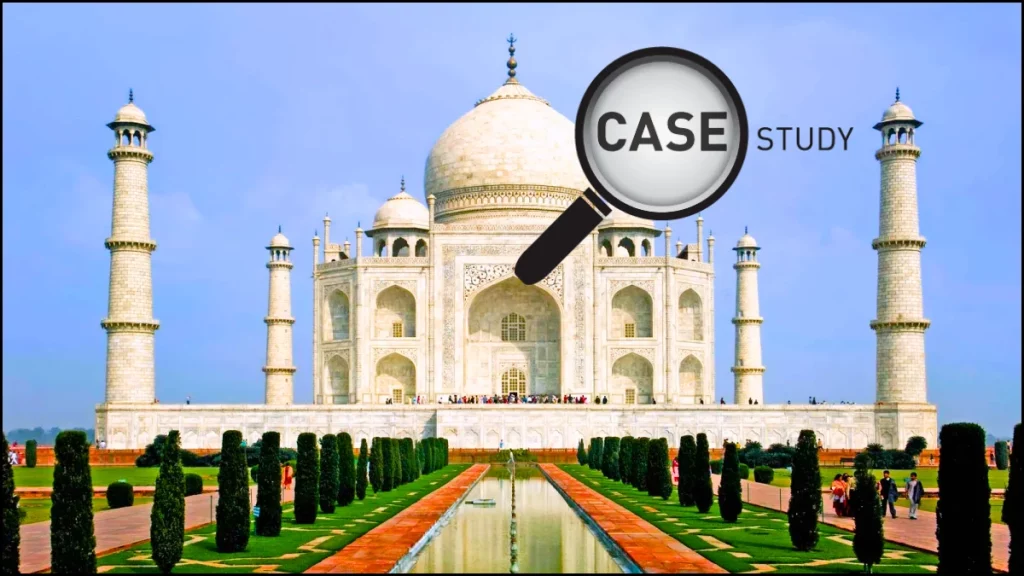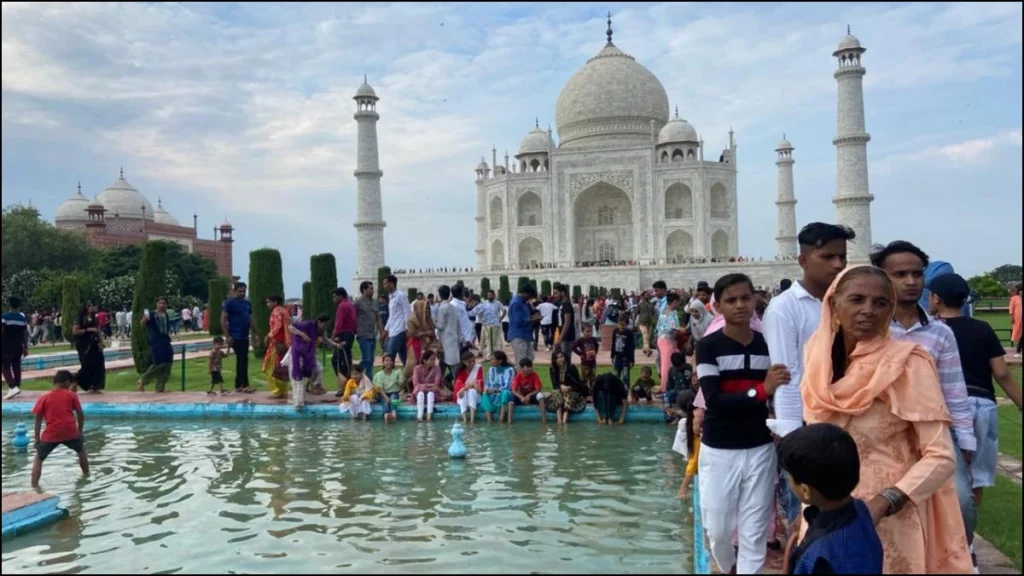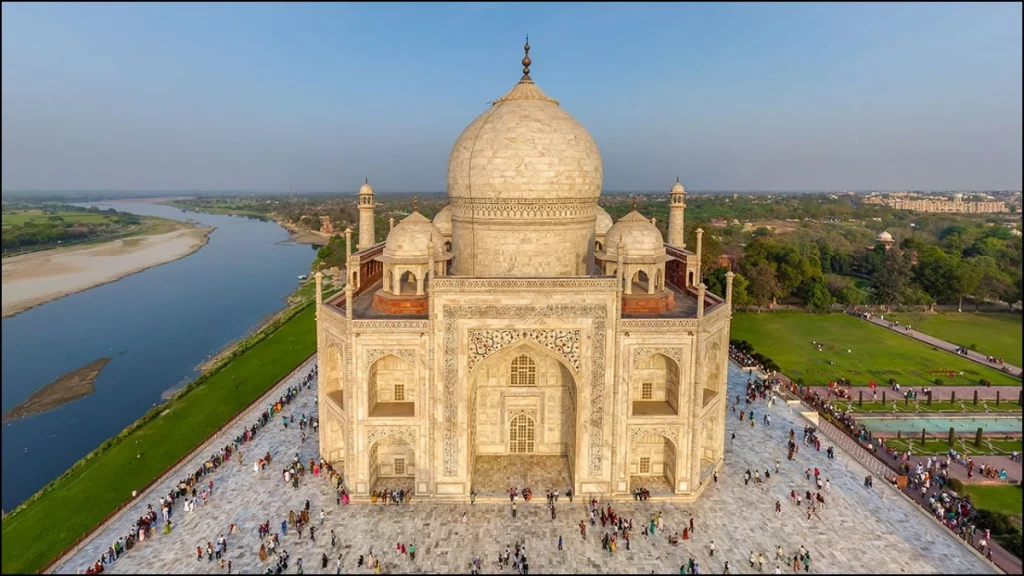Taj Mahal which is among the seven wonders of the world has a successful as well as exciting tale that one must read!

Taj Mahal which is regarded as the masterpiece of Mughal architecture, and stands as an epitome of love and cultural brilliance in the heart of India, and has become a well recognized tourist attraction all over the globe.
This mausoleum was built in the rulership of emperor Shah Jahan in the memory of his beloved wife Mumtaz Mahal who died in 1631.
The tomb of both the emperor and the queen were graved in the monument only, and thus is regarded as the mausoleum.
Taj Mahal History Overview
Taj Mahal which is being considered as the monument of love and how it should be expresses and is among the seven wonders of the world. It has an enchanting tale to read!
| Aspects | Description |
| Taj Mahal Build | Taj Mahal was built under the rulership of Emperor Shah Jahan for his favorite wife, i.e. Queen Mumtaz Mahal between the years 1632-1648, to house the tomb of his wife, and later his. |
| Why was the monument built? | The mausoleum monument was built after the emperor’s beloved wife Mumtaz Mahal died in 1631 during the birth of their 14th child. |
| Purpose of monument | The last wish of the queen was to have a symbol or a monument of their love. Also with that she asked the emperor not to marry anyone else, and the emperor immediately promised her to fulfill her last wishes. |
| Cost of making the monument in 1600s | Total cost of making it was around INR 32 million. |
| Cost as of today | The cost of making the Taj Mahal would be around INR 35 billion (2023). |
| Materials used | Material for making the monument were taken from over India and Asia. |
| Transport medium and workers | According to the experts over 1,000 elephants were used to transport building materials, and around 22,000 laborers, stone cutters, embroidery artists, painters worked to build the monument. |
| Heritage site declaration | In 1983, UNESCO, declared Taj Mahal as the heritage site and for being the jewel of Muslim art in India and one of the universally admired and praised masterpieces of the world’s heritage. |
| Among seven wonders of the world | Taj Mahal declared as the winner of new seven wonders of the world initiative in 2007, as it attracts around 7-8 million visitors a year. |
Taj Mahal, the epitome of love and beautiful architecture incorporates great Indo-Islamic designs and patterns.
Along with that marks a huge difference in cost of its making as compared to its original cost and the cost of now. Apart from that it was recognized by UNESCO for its amazon beauty and culture and declared as a heritage site to visit in 1983.
Case Study Of Taj Mahal: The Business It Brings To India
(A) Case Study of Taj Mahal: Revenue Generation
| Year | Revenue |
| FY 19-20 | Rs.97.5 crores |
| FY 20-21 | Rs.11.29 crores |
| FY 21-22 | Rs.31.92 crores |
| FY 22-23 | Rs.81.89 crores |
| FY 23-24 | Undisclosed |
Between FY19-20 and FY20-21, ASI (Archeological Survey Of India), reported that Taj Mahal alone has contributed 24% to the total revenue by monuments.
While it witnessed a fall in its revenue numbers due to the covid-19 pandemic, and recorded a number of Rs 11.29 crores in 2020-21. However, it recovered to Rs 31.92 crores in the next financial year before rolling back to Rs 81.89 cores in 2022-23.
While the numbers for FY 23-24 haven’t been disclosed yet.
(B) Taj Mahal Visitors Analysis
| Year | Number of Visitors |
| 2019 | Around 48,35,000 thousand visitors (domestic) & over 7,37,000 thousand visitors (foreign) |
| 2020 | 11,34,000 thousand visitors |
| 2021 | 1,31,53,076 crores visitors |
| 2022 | 2,60,46,891 crores visitors |
| 2023 | Around 7-8 million |
Taj Mahal visitors have increased over the years, however in the year 2020 it suffered a dip in its visitors annually due to covid-19 pandemic and recorded a number of 11,34,000 visitors.
At that time only the number of visitors were allowed to enter the monument due to safety reasons.
(C) Ticket Price Analysis
For Indian tourists
| Monuments | Weekdays prices except Friday | Friday Charges |
| Taj Mahal | Rs.50 | Closed |
| Fatehpur Sikri | Rs.50 | Rs.40 |
| Akbar’s tomb, Sikandra | Rs.30 | Rs.25 |
| Mehtab Bagh | Rs.25 | Rs.25 |
| Agra Fort | Rs.50 | Rs.40 |
| Itidmad-Ul-Daulah | Rs.30 | Rs.25 |
| Mariyam’s tomb | Rs.25 | Rs.25 |
| Ram Bagh | Rs.25 | Rs.25 |
For Foreign tourists
| Monuments | Weekdays Prices except Friday | Friday Charges |
| Taj Mahal | Rs.1100 | Closed |
| Fatehpur Sikri | Rs.610 | Rs.600 |
| Akbar’s tomb, Sikandra | Rs.310 | Rs.300 |
| Mehtab Bagh | Rs.300 | Rs.300 |
| Agra Fort | Rs.650 | Rs.600 |
| Itidmad-Ul-Daulah | Rs.310 | Rs.300 |
| Mariyam’s tomb | Rs.300 | Rs.300 |
| Ram Bagh | Rs.300 | Rs.300 |
The charges for Indian tourists are half of what Taj Mahal charges for foreign tourists. For foreign tourists the charges are 4x double of Indian charges. All resulting in a pretty good source for business and revenue for Taj Mahal.
Along with that there are some other sets of rules for the charges, i.e. tourists buying tickets online will get a discount of Rs.5/- for each Indian ticket & Rs. 50/- for each Foreigner ticket.

While there is no entry fee charged for the children who are below the age of 15 years old (for both domestic and foreigner).
Additional Rs.200 will be charged if someone wants to visit the main mausoleum. This was done in the wake of the new arrangement introduced in 2018. This led to an additional collection of Rs 17.76 crore which was received by the ASI.
(D) The Most Visited Monument
Taj Mahal becomes the most visited ticketed monument for the year 2022 and 2023. Among all the monuments present in India.
| Monument Name | Number of Visitors (2022) |
| Taj Mahal | Around 3.3 million |
| Red Fort | Over 1.2 million |
| Qutub Minar | Above 1 million |
| Group of Monument | Over 1.1 million |
| Agra Fort | 1 million |
| Golconda Fort | Over 0.9 million |
Taj Mahal tops the list and was the most visited monument for the year 2022 and 2023, following it ranks Red Fort at the second spot in the list. Following it is Qutub Minar, and other monuments.
(E) Other Factors of the Business that Taj Mahal Brings
| Other Factors | Description |
| Tourism Boom | One of the primary businesses that Taj Mahal brings to India is the millions of tourists every year, leading to a thriving Indian tourism industry. Also becomes a good source for the revenue. |
| Employment Opportunities | The monument serves as a base for generating more employment, that goes from tour guides, hotel staff, to ticket sellers. |
| Cultural Exchanges | There is no doubt that Taj Mahal is a global attraction and among the seven wonders of the world. Therefore it attracts a lot of cultural exchanges, events, festivals, etc. |
| Transportation Services | As the number of tourists increases, the transportation service along with it also increases. Be it the taxis, tour buses, normal buses, rickshaws, the demand of these creates business opportunities for the local ones. |
| Hospitality Sector | The inclusion of tourists accelerated the demand for more hotels, guesthouses and restaurants in the place. |
| Local Businesses | The local shops, street vendors, markets around Taj Mahal benefit from the tourists visiting the place. |
Apart from the above factors stated, Taj Mahal also serves as the heritage site and cultural exchanges as it is praised by people across the world and attracts a good amount of visitors everyday, all which contributes to more business to people in India.
Note: Visit the following articles too-
Case Study Of Taj Mahal: Summing Up
In the end, Taj Mahal, beyond stating as a symbol of cultural and historical significance, is a testament to economic generation in India. Be it boosting the tourism industry, transportation sector, local business, etc. all of it contributes to business growth in India.

All these factors and architecture have made the case study of Taj Mahal a notable one. Apart from this, ensuring the sustainability of economic development and preserving the monument stability, remains a crucial aspect of having the monument for the rest of the time.
